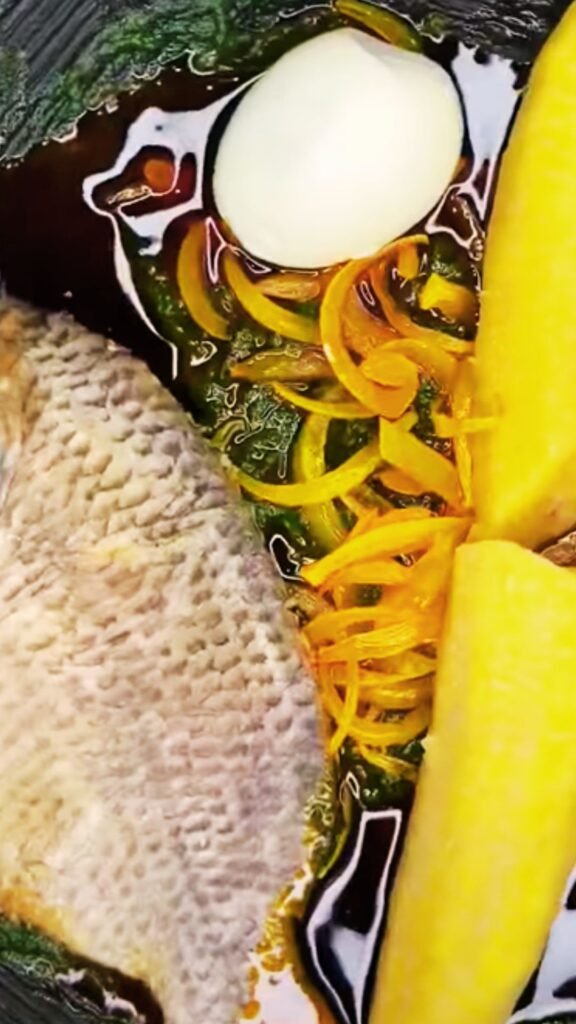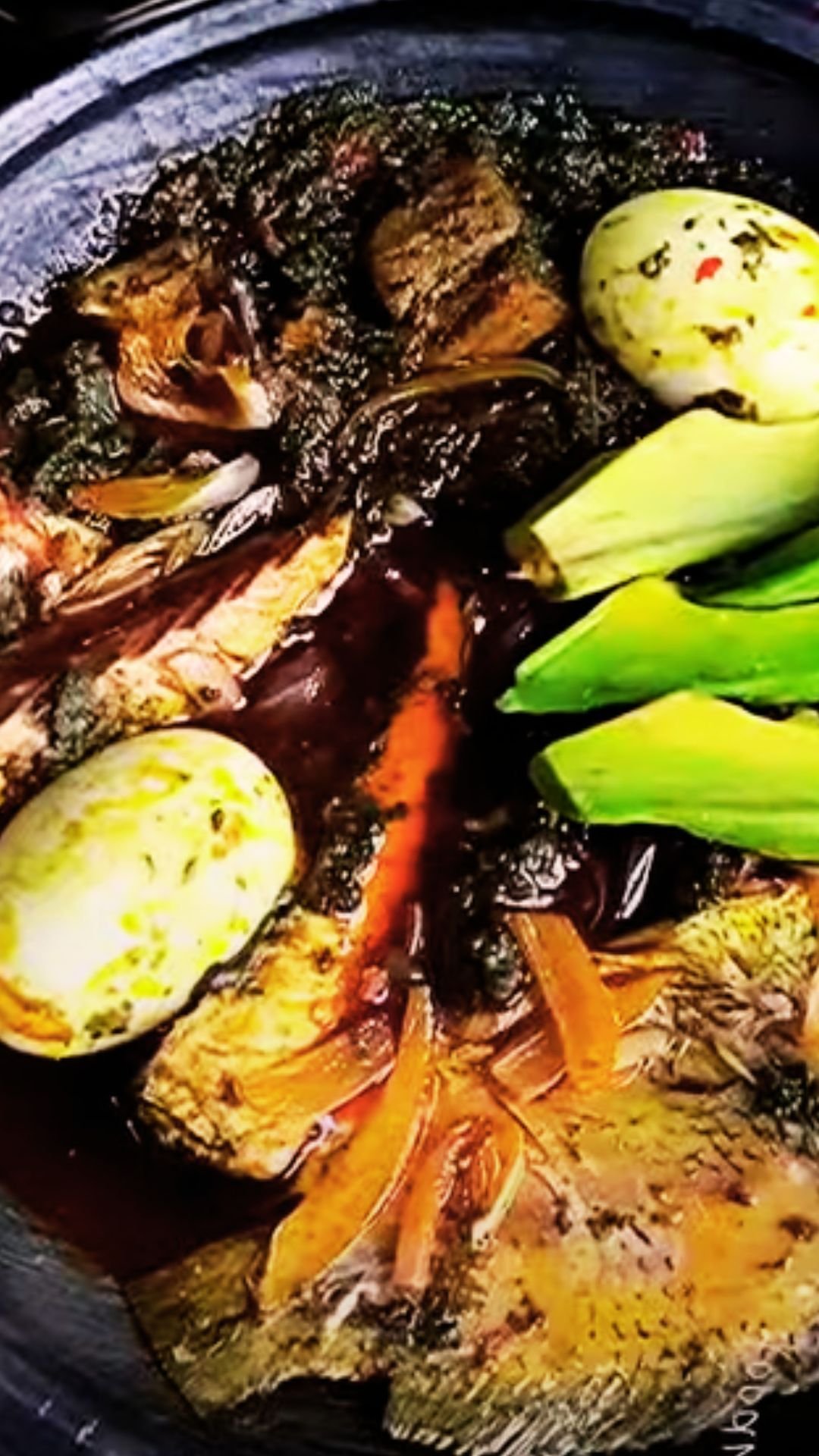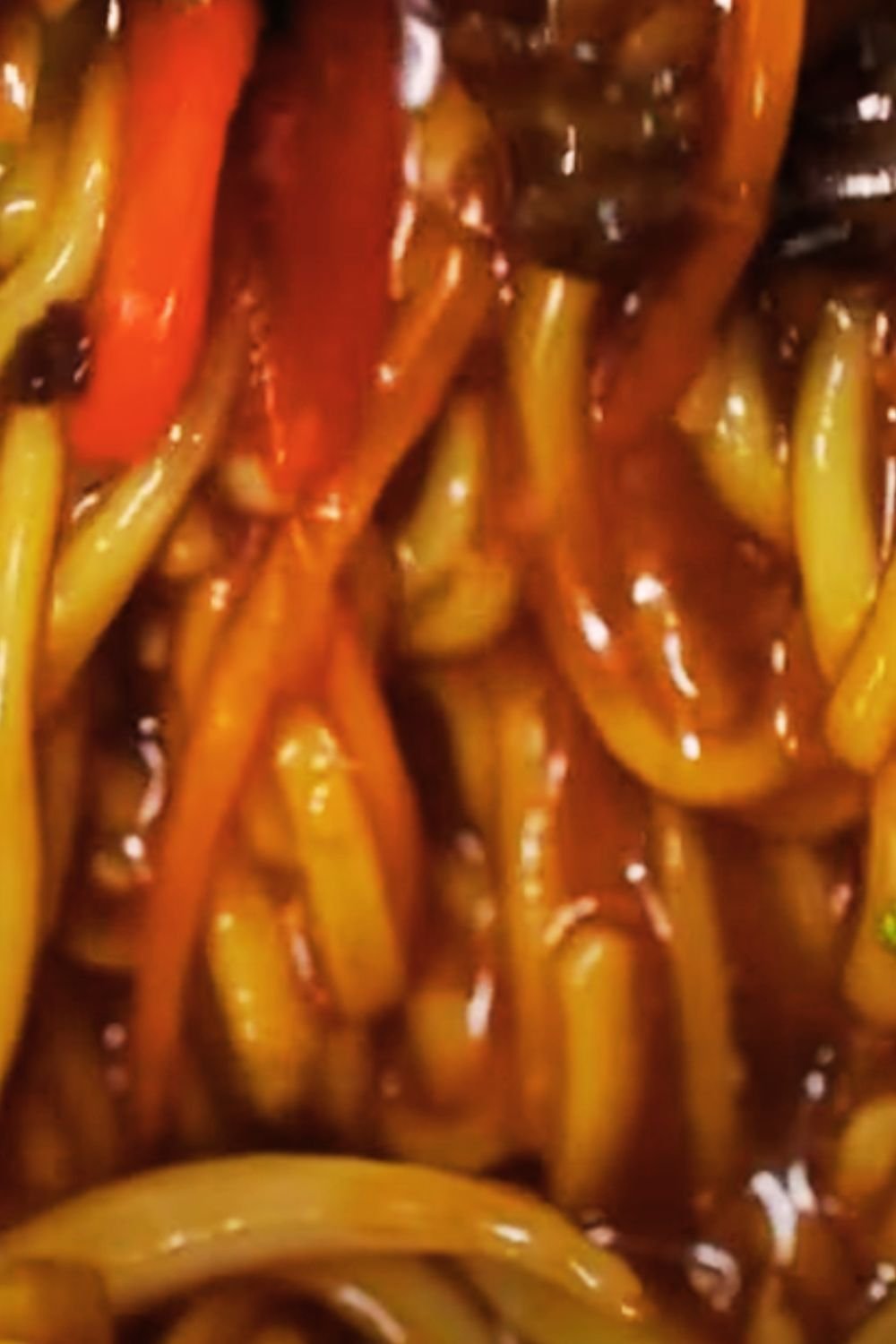When I first encountered Kontomire and Ampesi during my culinary journey through Ghana, I was immediately struck by how this humble yet extraordinary dish represents the very soul of Ghanaian home cooking. The aromatic blend of cocoyam leaves simmering alongside perfectly boiled tubers creates a harmony that speaks to generations of tradition and nutritional wisdom.
This beloved combination isn’t just a meal—it’s a cultural experience that brings families together around the dinner table. The gentle bubbling of the pot, the earthy fragrance of fresh kontomire leaves, and the comforting sight of golden yams and plantains create an atmosphere that transforms a simple kitchen into the heart of a Ghanaian home.
Understanding the Foundation: What Makes This Dish Special
Kontomire refers to the tender young leaves of the cocoyam plant (Xanthosoma sagittifolium), known scientifically as taro leaves in other parts of the world. These nutrient-dense greens form the backbone of countless Ghanaian dishes, prized for their distinctive flavor profile and exceptional nutritional value.
Ampesi, on the other hand, represents the art of perfectly boiled tubers and vegetables. The term encompasses various root vegetables and plantains that are cooked together to create a satisfying, starchy foundation that complements the kontomire beautifully.
Together, these elements create a dish that’s both nourishing and deeply satisfying, embodying the Ghanaian philosophy of food as medicine and comfort.
The Cultural Significance Behind Every Bite
In Ghana, Kontomire and Ampesi holds a special place in the culinary landscape that extends far beyond mere sustenance. I’ve observed how this dish serves as a bridge between generations, with grandmothers teaching young mothers the precise techniques for selecting the freshest kontomire leaves and achieving the perfect texture for the ampesi.
The preparation of this dish often becomes a communal activity, particularly during family gatherings and traditional celebrations. Women gather in the kitchen, sharing stories and wisdom while carefully cleaning the kontomire leaves and preparing the various tubers. This social aspect transforms cooking from a chore into a cherished bonding experience.
From a nutritional standpoint, this combination represents the sophisticated understanding of balanced nutrition that characterizes traditional African cuisine. The kontomire provides essential vitamins and minerals, while the ampesi offers complex carbohydrates and sustained energy—creating a meal that nourishes both body and soul.
Essential Ingredients: Building Your Flavor Foundation
Primary Components
The success of authentic Kontomire and Ampesi depends entirely on the quality and freshness of your ingredients. Here’s what you’ll need to create this masterpiece:
For the Kontomire:
- 2 pounds fresh cocoyam leaves (kontomire), carefully cleaned and chopped
- 1 large onion, finely diced
- 4 cloves garlic, minced
- 2 inches fresh ginger, grated
- 2 tablespoons palm oil (essential for authentic flavor)
- 1 pound smoked fish (preferably herrings or mackerel)
- 1/2 pound dried fish, soaked and cleaned
- 2 tablespoons ground crayfish
- 2 scotch bonnet peppers (adjust to taste)
- 1 tablespoon tomato paste
- 2 seasoning cubes
- Salt to taste
For the Ampesi:
- 2 pounds yam, peeled and cut into chunks
- 4 ripe plantains, peeled and halved
- 1 pound cocoyam, peeled and chunked
- 1 pound sweet potatoes, peeled and chunked
- 1 large cassava root, peeled and cut into pieces
- Salt for boiling water
Quality Selection Tips
When selecting kontomire leaves, I always look for young, tender leaves with vibrant green color and no signs of yellowing or wilting. The leaves should feel firm to the touch and have a fresh, earthy aroma. Avoid leaves with brown spots or those that appear overly mature, as they can be tough and bitter.
For the ampesi components, choose tubers that feel firm and heavy for their size. Yams should have smooth, unblemished skin, while plantains should be ripe but still firm—not overly soft or mushy.
Nutritional Profile: Understanding the Health Benefits
| Nutrient Category | Kontomire Leaves | Ampesi Components | Combined Benefits |
|---|---|---|---|
| Vitamins | High in Vitamin A, C, K, and folate | Rich in Vitamin C, B6, and beta-carotene | Comprehensive vitamin profile supporting immune function and cellular health |
| Minerals | Excellent source of iron, calcium, magnesium | High in potassium, manganese, phosphorus | Supports bone health, muscle function, and cardiovascular health |
| Fiber Content | 3.2g per 100g serving | 2.8-4.1g per 100g (varies by tuber) | Promotes digestive health and blood sugar regulation |
| Protein | 4.8g per 100g | 1.5-2.0g per 100g | Provides essential amino acids for muscle maintenance |
| Antioxidants | High levels of flavonoids and phenolic compounds | Carotenoids and vitamin C | Powerful anti-inflammatory and anti-aging properties |
| Calories | 35 calories per 100g | 80-160 calories per 100g (varies by tuber) | Balanced energy density for sustained nutrition |
This nutritional profile makes Kontomire and Ampesi an excellent choice for maintaining optimal health while enjoying a deeply satisfying meal. The combination provides sustained energy, essential micronutrients, and powerful phytocompounds that support overall wellness.
Step-by-Step Preparation: Mastering the Technique
Preparing the Kontomire
The preparation of kontomire requires patience and attention to detail. I begin by thoroughly washing the leaves under cold running water, removing any dirt or debris. The leaves must be cleaned multiple times until the water runs completely clear.
Next, I remove the tough stems and midribs from each leaf, then stack several leaves together and roll them tightly before cutting them into thin strips. This technique, known as chiffonade, ensures even cooking and optimal texture.

After cutting, I place the kontomire in a large bowl and add a generous amount of salt, then massage the leaves gently with my hands. This process helps break down the cellular structure, making the leaves more tender and reducing any potential bitterness.
Cooking the Ampesi
The ampesi preparation begins with bringing a large pot of salted water to a rolling boil. I add the tubers in order of their cooking time requirements—cassava first, followed by yam and cocoyam, and finally the plantains and sweet potatoes.
The key to perfect ampesi lies in timing and temperature control. Each component should be tender but not mushy, maintaining its individual character while harmonizing with the others. I test for doneness by inserting a fork into the center of each piece—it should slide in easily without resistance.
Bringing It All Together
In a separate heavy-bottomed pot, I heat the palm oil over medium heat until it begins to shimmer. The aroma of quality palm oil is unmistakable—rich, nutty, and slightly sweet. I add the diced onions and cook until they become translucent, then incorporate the minced garlic and grated ginger.
The tomato paste goes in next, and I cook it for about two minutes to develop its flavor before adding the prepared kontomire. The leaves will initially seem like an enormous quantity, but they reduce significantly as they cook.
I add the smoked fish, dried fish, and ground crayfish, then season with the scotch bonnet peppers, seasoning cubes, and salt. The mixture simmers gently for about 20-25 minutes, stirring occasionally to prevent sticking.
Regional Variations and Personal Touches
Throughout Ghana, different regions have developed their own unique approaches to this classic dish. In the Northern regions, I’ve encountered versions that incorporate guinea fowl or local game meat, while coastal areas often emphasize the seafood components with fresh crab or prawns.
Ashanti Region Variations
In the Ashanti region, cooks often add a small amount of dawadawa (locust bean paste) to deepen the umami flavors. This fermented seasoning adds a complex, savory note that complements the earthiness of the kontomire beautifully.
Volta Region Influences
The Volta region’s proximity to the coast influences their version with the addition of fresh fish and sometimes palm wine during cooking, which adds a subtle sweetness and helps tenderize the leaves more quickly.
Northern Ghana Adaptations
Northern Ghanaian variations sometimes include groundnuts (peanuts) ground into a paste, creating a richer, more protein-dense version that reflects the region’s agricultural focus on legumes and nuts.
Cooking Techniques and Professional Tips
Temperature Control Mastery
Maintaining the correct temperature throughout cooking is crucial for achieving the perfect texture. I keep the heat at medium-low once all ingredients are combined, allowing the flavors to meld without overcooking the delicate kontomire leaves.
Seasoning Balance
The art of seasoning Kontomire and Ampesi lies in building layers of flavor. I taste and adjust seasonings multiple times during cooking, understanding that the saltiness from the dried fish and seasoning cubes will intensify as the liquid reduces.
Texture Considerations
The final dish should have kontomire that’s tender but not mushy, with individual leaves still recognizable. The ampesi should be fork-tender but maintain its shape, and the overall consistency should be moist but not watery.
Serving Suggestions and Presentation
The traditional presentation of Kontomire and Ampesi emphasizes the natural beauty of the ingredients. I arrange the colorful ampesi components on one side of the plate, with the rich, dark green kontomire alongside, creating a visually appealing contrast.
Traditional Accompaniments
This dish pairs beautifully with several traditional Ghanaian accompaniments:
- Shito (Ghanaian pepper sauce) for those who enjoy additional heat
- Kelewele (spiced fried plantains) as a sweet and spicy side
- Fresh avocado slices to add creaminess and healthy fats
- Boiled eggs for additional protein
- Fried fish to complement the smoked fish in the kontomire
Modern Presentation Ideas
For contemporary presentations, I sometimes serve the kontomire in individual bowls with the ampesi artfully arranged around the perimeter of the plate. A drizzle of quality palm oil and a sprinkle of toasted groundnuts can elevate the visual appeal while maintaining authenticity.
Storage and Reheating Guidelines
Proper storage of Kontomire and Ampesi ensures food safety and maintains optimal flavor. I store leftover kontomire separately from the ampesi in the refrigerator, where it remains fresh for up to three days.
Refrigeration Best Practices
- Store kontomire in airtight containers to prevent oxidation
- Keep ampesi in separate containers to maintain individual textures
- Label containers with preparation dates for food safety
- Allow foods to cool completely before refrigerating
Reheating Techniques
When reheating, I prefer using low heat and adding a small amount of water or broth to prevent drying. The kontomire can be gently warmed in a covered pot, while the ampesi can be steamed or microwaved until heated through.
Troubleshooting Common Issues
Bitter Kontomire
If your kontomire tastes bitter, it’s likely due to older leaves or insufficient cleaning. Always select young, tender leaves and clean them thoroughly. The salt massage technique I mentioned earlier also helps reduce any residual bitterness.
Mushy Ampesi
Overcooked ampesi loses its appealing texture. To prevent this, test for doneness frequently and remove pieces as they reach the desired tenderness. Different tubers cook at different rates, so individual attention is essential.
Watery Consistency
If your kontomire is too watery, increase the heat slightly and cook uncovered for the final few minutes to allow excess moisture to evaporate. This concentrates the flavors and improves the overall texture.
Seasonal Considerations and Ingredient Substitutions
Seasonal Availability
Fresh kontomire is typically most abundant during Ghana’s rainy seasons. During dry periods, I’ve learned to work with what’s available, sometimes using frozen kontomire or even spinach as a substitute, though the flavor profile changes significantly.
Acceptable Substitutions
| Original Ingredient | Suitable Substitute | Flavor Impact | Notes |
|---|---|---|---|
| Fresh Kontomire | Frozen kontomire | Minimal change | Thaw and drain thoroughly before use |
| Palm Oil | Vegetable oil + red palm oil extract | Moderate change | Won’t achieve the same depth of flavor |
| Smoked Fish | Smoked turkey or chicken | Significant change | Alters the traditional seafood profile |
| Scotch Bonnet Peppers | Habanero or jalapeño | Moderate change | Adjust quantity based on heat preference |
| Ground Crayfish | Shrimp powder | Minimal change | Provides similar umami depth |
Health Benefits and Dietary Considerations
The health benefits of Kontomire and Ampesi extend far beyond basic nutrition. This combination provides a excellent foundation for various dietary needs and health goals.
Digestive Health Support
The high fiber content from both the kontomire and ampesi components promotes healthy digestion and regular bowel movements. The variety of fibers—both soluble and insoluble—feeds beneficial gut bacteria and supports overall digestive wellness.
Blood Sugar Management
Despite containing starchy tubers, the combination of fiber, protein, and healthy fats in this dish helps moderate blood sugar spikes. The complex carbohydrates provide sustained energy without causing dramatic glucose fluctuations.
Cardiovascular Benefits
The potassium from the tubers, combined with the antioxidants in the kontomire, supports heart health by helping regulate blood pressure and reducing inflammation in the cardiovascular system.
Immune System Support
The high vitamin C content, along with other antioxidants and phytonutrients, provides robust support for immune function. Regular consumption of dishes like this contributes to the overall resilience that characterizes traditional diets.
Cultural Etiquette and Serving Traditions
Understanding the cultural context surrounding Kontomire and Ampesi enhances appreciation for this remarkable dish. In traditional Ghanaian households, this meal often represents more than sustenance—it’s a symbol of hospitality, care, and cultural continuity.
Family Meal Dynamics
I’ve observed that the serving of Kontomire and Ampesi often follows specific family protocols. Elders are typically served first, followed by guests, then other family members. This hierarchy reflects the deep respect for age and hospitality that characterizes Ghanaian culture.
Communal Eating Practices
In some traditional settings, family members eat from shared bowls, using their right hands to take portions. This communal approach strengthens family bonds and ensures that everyone receives adequate nutrition.
Questions and Answers
Q: How do I know when the kontomire leaves are properly cooked?
The kontomire leaves should be tender enough to cut easily with a fork but still maintain some texture. They shouldn’t be mushy or fall apart completely. The cooking time is typically 20-25 minutes, but the best indicator is texture rather than time.
Q: Can I prepare Kontomire and Ampesi in advance for meal prep?
Absolutely! This dish actually improves in flavor when prepared ahead of time. I recommend cooking both components fully, then storing them separately in the refrigerator. The flavors meld beautifully overnight, and you can reheat portions as needed throughout the week.
Q: What’s the best way to clean kontomire leaves thoroughly?
I use a three-step cleaning process: first, rinse the leaves under cold running water to remove surface dirt. Second, fill a large bowl with water and swish the leaves around, then drain. Finally, inspect each leaf individually, removing any damaged portions or tough stems. The water should run completely clear after the final rinse.
Q: Is it possible to make this dish vegetarian while maintaining authentic flavors?
Yes, you can create a delicious vegetarian version by omitting the fish and increasing the ground crayfish or using mushroom powder for umami depth. Some cooks add extra seasoning cubes or a small amount of soy sauce to compensate for the missing fish flavors.
Q: How can I adjust the spice level for children or those sensitive to heat?
Remove the seeds from the scotch bonnet peppers before adding them, or substitute with milder peppers like bell peppers for color without heat. You can always serve additional shito or hot sauce on the side for those who want more spice.
Q: What’s the difference between using fresh versus frozen kontomire?
Fresh kontomire provides the best texture and flavor, with leaves that hold their shape better during cooking. Frozen kontomire works well but may be slightly softer and require less cooking time. Always thaw frozen kontomire completely and drain excess water before cooking.
Q: How do I prevent the ampesi from becoming mushy during cooking?
The key is to add different tubers at different times based on their cooking requirements. Start with the hardest vegetables like cassava, then add yam and cocoyam, and finish with plantains and sweet potatoes. Test each piece individually with a fork—they should be tender but still hold their shape.
Q: Can I substitute other leafy greens if kontomire isn’t available?
While kontomire has a unique flavor, you can substitute with collard greens, kale, or even spinach. However, these alternatives will change the authentic taste significantly. Collard greens come closest to kontomire in texture and cooking behavior.
This beloved Ghanaian dish represents much more than a simple meal—it’s a celebration of tradition, nutrition, and the profound satisfaction that comes from preparing food with love and intention. Whether you’re cooking for family, friends, or simply treating yourself to an authentic culinary experience, Kontomire and Ampesi offers a delicious journey into the heart of West African cuisine.
The beauty of this dish lies not just in its flavors, but in its ability to bring people together, nourish both body and soul, and connect us to generations of culinary wisdom. Each time I prepare Kontomire and Ampesi, I’m reminded of the incredible richness of Ghanaian food culture and the simple joy of sharing a meaningful meal with others.


